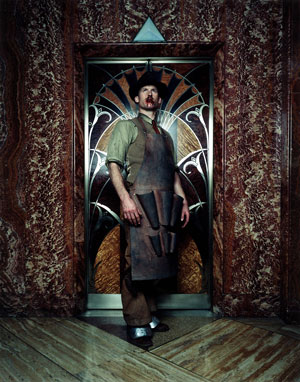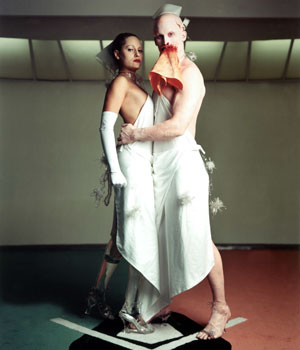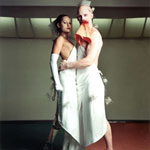Matthew Barney’s Cremaster series finale is a three-hour epic that will make you grit your teeth and drop your jaw — often in quick succession.
Previous Cremasters merged the breathless theatrics of sports telecasts with the slow-paced grandeur of opera to invent obscure spectacles and insensate ceremonies. This time, two of New York’s most celebrated architectural icons — the Chrysler building and the Guggenheim Museum — are the main characters, the mountains on which Barney’s antlike characters swarm. Spike and spiral, male and female, Freud and Jung — you name it — these two 20th century masterpieces are polar opposites. But in their different ways, both buildings exemplify ultra-sensuality confounding function. Barney uses them to good effect as the embodiments of his complicated mythic structure, which is more of a succession of vignettes than a plot-driven narrative.
But despite the obvious male/female symbolism embodied in these settings, the tone of Cremaster 3 is, like most of Barney’s films, voluptuously chaste. The movie’s prologue, which is pure Hobbit, defies analysis, except to say that is shows people coping with wrack and ruin in a beautiful, antediluvian setting. After this, we are introduced to a modern New York that, by contrast, does seem shocking and new. The lobby of the Chrysler building is the setting for a vehicular ballet (it is the Chrysler building, after all), with a 1930s vintage model saluted by a bevy of newer, more grandiose models from the 60s (I recognized the Imperial) that form and reform the Chrysler logo around the older car’s central axis. Meanwhile, The Entered Apprentice (Barney), in pre-war garb and wearing a leather apron customized to holster 6 crystals, begins to climb an elevator shaft. As he climbs, the newer cars turn on the older one, commencing a relentless demolition derby.
While the car-crash rumble proceeds below, Apprentice gains entrance to the shaft’s car, activates the sprinkler system, and uses the water to mix mortar, some of which fills the elevator car before he gains access to the Cloud Club, the Chrysler Building upper level private club. Here the sturm and drang of the lobby scenes is contrasted with an overemphasis on the Chrysler’s pentagonal logo. The Celtic mythos of the prologue also returns; but while there is no blarney stone, there is room for plenty of blarney and folderol. The bartender fondles the bar’s phallic pull-tap before commencing a joyless slapstick romp that deconstructs the bar into a rush of beer suds and broken glass. The maitre d’ sings and plays an Aeolian harp that Apprentice constructed from elevator cables on his way out of the shaft, while some tough customers, looking for all the world like refugees from a Beckett play, grasp the Masonic Lodge’s symbolic tools, trying to recreate the sect’s rituals in the privacy of their own well-paneled inner sanctum.
In short, a positively medieval human dynamic overwhelms the implications of progress embodied by the Chrysler building’s technological innovations and craft refinements. But if the Chrysler scenes are not exactly joyous, they are continually seductive in their opulent detailing. Barney’s Entered Apprentice may be a crystal-packing mason, but the tough customers eventually figure out how to don their own Masonic aprons, and then — they turn into dentists! They set to work on Apprentice. After revealing his strange genitals, they apply a facemask and practice gruesome oral surgery. Architect Hiram Abiff (Richard Serra) enters, delivering a core fragment of the by-now demolished vintage Chrysler. The Masonic dentists insert this into the Apprentice’s mouth, and all manner of surprises, lots of bodily fluids, and a novel interpretation of the “tooth fairy” ensue.
The irony of Richard Serra, minimalist archetype, lending his image to promote Barney’s almost Victorian symbolic overload is one of the nicer ironies in this highly ironic movie, but Serra is effective in his role. Incongruously, he wears white dress gloves (like almost everyone else in the movie, except Barney), even as he constructs most un-Serra-like sculptures that he uses to ascend to the Chrysler segment’s climactic scenes, which involves the raising of the buildings topmost spire. As the spire is hoisted in place, tendril-like garlands descend (apparently this scene is historically based), and studious male attendants deliver elaborate floral bouquets to architect Abiff. The Entered Apprentice enters, only to have a spike driven into his head.
What does it mean? I don’t know, except that a major subtext involved sacred fluids, and that — calling Dr. Freud — my pen ran dry shortly after the conclusion of the Chrysler building segment. You name a polarity: geometry versus human form, metal versus goo, antediluvian versus modern…like an archeologist’s recreation of Druid ritual, there are any number of inversions or inventions that you could attribute to the arcane ceremonies Barney distills from the Chrysler’s pointy, male-membered form. But if the machinations and machinery that haunt part one of Cremaster 3 don’t do it for you, stay tuned for part two, which reprises many of the same characters of part one. Set in the Guggenheim Museum, the second half is decidedly more upbeat, sexy (lots of pasties, g-strings, and high-kicking Rockettes), and set in the recognizable present. The Entered Apprentice is now clad in a customized (peach-colored!) tartan kilt, with a bloody satin rag in his mouth to remind us of his earlier tribulations. As in part one, Barney indulges in his penchant for climbing, ascending the Guggenheim’s seven rings the hard way, and encountering challenges and accomplishing deeds that can only be seen as a recasting of the seven labors of Hercules. Other than that, I cannot say, except that leg kicks are a lot more visually interesting than car crashes.
I was underwhelmed by Barney’s recent Guggenheim show, where his sculptures, arrayed in ramped procession, seemed an afterthought, little more than a succession of props and stage sets. But his video projections did catch and hold my eye, and I find myself (this is hard to say, given all the idiosyncrasies involved in Cremaster 3) respecting him as a filmmaker. In both sections, dress (not flesh or bodily functions revealed or hinted at) provides the pivotal shorthanding of each character’s strengths and foibles that the nearly absent, monosyllabic script makes no effort to construct. Part two of Cremaster 3, even at its silliest (whatever gave rise to the cheetah woman played by Aimee Mullins?), bears this out. And for all the exposed flesh, it is this ability to conjure a sense of blocked revelation that captures the prudish heart of any film voyeur. Despite the convoluted plots that he has developed and apparently kept intact since late childhood, I don’t think Barney cares a whit about storytelling. His art leaves the plot in the hands of the viewer, while he constructs the scenarios that can enable visions. In his own weird way, he, like James Turrell, is a sculptor who has succeeded by finding a way to use light as his medium.
For those who dare, the MFAH will host an 8-hour Cremaster Cycle marathon on September 1, beginning at 11:30 am. The five films will be shown consecutively, with a one-hour break at 1:45 pm. Cremaster double-bills will also take place September 5-14. All screenings take place in the Brown Auditorium Theater and begin at 7 pm. The MFAH will premier the Cremaster Cycle in Texas, but successive screenings are scheduled for later dates at museums across the state. Running times and absurdly simplistic capsulations follow.
Cremaster 1, 1995 (45 minutes; September 5 and 12)
Overhead synchronicities befitting a Busby-Berkeley showgirl spectacle, plus a pair of Goodyear blimps and a platinum blonde starlet with a penchant for geometric patterns.
Cremaster 2, 1999 (79 minutes; September 5 and 12)
The convoluted plot intersects Gary Gilmore (Barney); Houdini (Norman Mailer); bees; a Brahma Bull; and the Mormon Tabernacle Choir, among others.
Cremaster 3, 2002 (182 minutes; September 6 and 13)
The Entered Apprentice (Barney) climbs the elevator shaft of the Chrysler Building and the ovals of the Guggenheim Museum, while architect Hiram Abiff (Richard Serra), assorted Masonic tough guys, a cheetah woman (Aimie Mullins), and chorus girls strut their stuff.
Cremaster 4, 1994 (43 minutes; September 7 and 14)
Well dressed satyr and Loughton Candidate (Barney) explores the bottom of the ocean and himself while color-coded motorcycle teams circle the Isle of Man.
Cremaster 5, 1997 (55 minutes; September 7 and 14)
The Queen of Chain (Ursula Andress) receives an operatic spectacle (Budapest Opera and Philharmonic Orchestra) while Barney, in a number of guises, cavorts with gender-neutral faeries and a flock of show pigeons.
Images courtesy the artist and the Museum of Fine Arts, Houston.
Christopher French is an artist and writer living in Houston.






